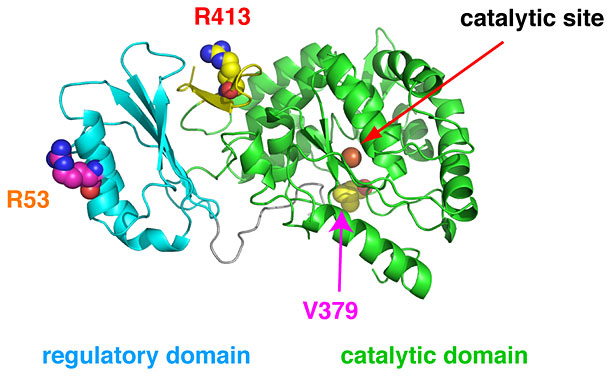News Releases & Research Results Genetic Diversity of Enzymes Alters Metabolic Individuality
News Releases & Research Results
Tohoku University Tohoku Medical Megabank Organization
Japan Agency for Medical Research and Development (AMED)
Sendai, Japan, September 2, 2016 – Tohoku University Tohoku Medical Megabank Organization (ToMMo) is pleased to announce the published research article about genetic diversity and metabolome by Dr. Seizo Koshiba et al. on Scientific Reports.
Dr. Koshiba said, “We discovered genetic variants affecting enzymatic activities in healthy people. Our study shows that genetic polymorphisms, the structural location of mutation, and effects for phenotype correlate with each other in human population. We imply that metabolic individuality and susceptibility for diseases possibly result from the moderate variants and much more deleterious but rare variants.”
Metabolomics is important for investigating the causes of diseases because metabolite levels are influenced by genetic and environmental factors.
The relationship between structural variations of enzymes and quantitative diversity of blood metabolic phenotypes in human population was surveyed on a large-scale cohort association study of metabolite concentrations with whole genome sequence analysis data.
We discovered five associations between metabolites and genetic variants. Four of these genetic variants are located in enzymes involved in metabolic disorders. The amino acids changed by these variants are located in peripheral regions of the catalytic sites or related regulatory domains of enzymes. One of these variants, R53H, is the non-synonymous substitution in the phenylalanine hydroxylase (PAH). PAH is important for a rate-limiting step in phenylalanine catabolism. Lower PAH activity causes hyper-phenylalaninemia (HPA). Our results show that the R53H variant increases phenylalanine concentration in plasma, indicating that this R53H substitution impaired the PAH activity. The PAH R53H variant is only found in East Asians. These results suggest that the ethnic differences of genetic variants also significantly influence plasma metabolite levels.
Some people showed higher phenylalanine levels without the R53H variant. We found that two persons have rare genetic variants, R413P and V379A. Arg413 is located on the interface between the catalytic domain and the C-terminal tetramerization domain and is also placed near the regulatory domain, indicating that this mutation affects the enzyme activity and/or stability of the protein complex. Val379 is located near the catalytic site, suggesting that this mutation directly affects the catalytic activity or destabilizes the enzyme.
ToMMo will study the environmental and genetic influence on individual difference of proteomics and metabolomics to discover useful biomarkers for disease prevention and early diagnosis through the identification and quantification of metabolites in blood. Such studies can contribute to the advancement of personalized prevention and treatment of diseases, as well as identification of disease mechanisms and development of novel therapeutics.
Subjects
Females: 320 people, mean age 56.6±12.1 years old
Total: 512 people, mean age 58.9±11.8 years old
These findings are from the analysis of plasma metabolites and whole genome sequence of 512 healthy participants living in Miyagi Prefecture in Japan from the Tohoku Medical Megabank Project Community-Based Cohort Study and Birth and Three-Generation Cohort Study conducted by ToMMo. A part of the data from 512 participants has already been released on the Japanese Multi Omics Reference Panel (jMorp).
Japanese Multi Omics Reference Panel (jMorp)
This summer, ToMMo will expand the number of subjects to more than 1,000. They were also whole-genome sequenced.
 Mapping of the gene variants on the structure of rat PAH
Mapping of the gene variants on the structure of rat PAH
Related Paper
- The structural origin of metabolic quantitative diversity
Scientific Reports 6, Article number: 31463
Published online: 16 August 2016
doi: 10.1038/srep31463 - Tohoku Medical Megabank Organization, Tohoku University

- Japanese Multi Omics Reference Panel (jMorp)

Press officer
Fuji Nagami
Tel: 022-717-7908
Fax: 022-717-7923
E-mail: f-nagami“AT”med.tohoku.ac.jp *Replace “AT” with "@"
Japan Agency for Medical Research and Development (AMED)
E-mail: kiban-kenkyu“AT”amed.go.jp *Replace “AT” with "@"
09/07/16
Last updated 09/07/16

